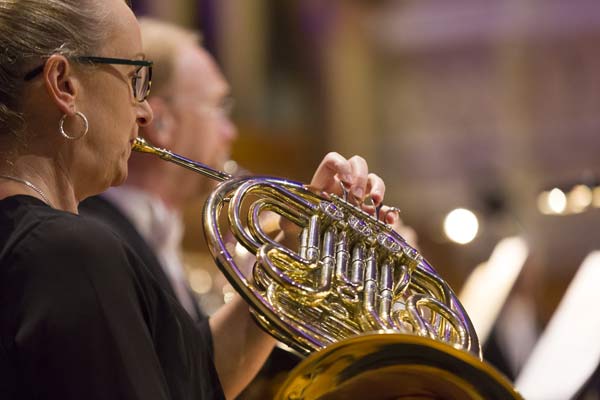Queensland Symphony Orchestra’s (QSO) Chamber Players series provides an opportunity for audiences to enjoy classical music in the comparatively informal setting of the QSO studio at South Bank.
At the same time, it also affords QSO musicians the opportunity to indulge some of their personal musical interests and demonstrate their prowess in forms that are missing from the larger tapestry of a symphony orchestra. For audiences too, the ability to tap into the larger pool of orchestra musicians means access to a range of music unlikely to be encountered in either an orchestra or a national tour chamber music format. Where else but here are we likely to encounter four French horns accompanied by a piano as a headline concert piece!
But before the French horns took to the stage, we were treated to Mozart’s String Quintet in D. Less common than the quartet, and variable in instrument makeup, the string Quintet was a more common musical form in Mozart’s time than it is now and Mozart wrote all six of his quintets in the two violin, two viola and cello format. This provides a lovely balance to the music, vigorously exploited by both composer and musicians. Lively, darting and unmistakably Mozart, the piece commences with a conversation between the cello and its smaller brethren, before gradually drawing us in to a much larger scale sound.

Because of the focus possible in a smaller venue and perhaps on account of the programming here, we were able to appreciate the joy that the musicians felt in their performance. The Mozart was a particular case in point, with nods and barely supressed smiles passing between them as the piece progressed towards its conclusion. This very much added to both the enjoyment of the audience, and the feeling of intimacy afforded by the venue.
The French horn sounds best when it is going full tilt, or on the other hand exploring the subtleties of the surprising quiet sounds it can make. In the middle register, it feels like there is less to interest or excite. This is an aspect that was clearly appreciated by Robert Schumann, and his Concertstück in F makes abundant use of both the strident and the subtle, with only occasional passages where one wonders if another instrument might have been more suitable. The best sections are those in which the dynamic range of the horn is stretched to its very limits.

The downside of the up close and personal format with brass instruments is that we were treated to the repeated spectacle of the players dismantling parts of their horns to divest them of the accumulated saliva that is an inevitable part of brass playing. In an orchestral setting, hidden behind ranks of string players, they can fling their spit around with alacrity. Front and centre of stage, this was on occasion a little confronting, even if it is an integral part of brass musicianship, and sometimes it was distracting, as we were on occasions left wondering whether the player was going to get their instrument back together again before their next passage came along!
Of course, they always did, and an encore of Rimsky-Korsakov’s Nocturne for four horns rounded off the afternoon perfectly, leaving the audience to drift free into a beautiful summer afternoon, suitably lifted by the occasion.
QSO has five Chamber Players concerts planned as part of their 2018 season.
Wolfgang Mozart (1756-1791)
String Quintet in D, K593
Rebecca Seymour, Natalie Low, Charlotte Burbrook de Vere, Graham Simpson, David Lale
Robert Schumann (1810-1856)
Concertstuck (Concert Piece) in F for Four Horns and Orchestra, Op.86
Malcolm Stewart, Peter Luff, Vivienne Collier-Vickers, Lauren Manuel, Kevin Power






